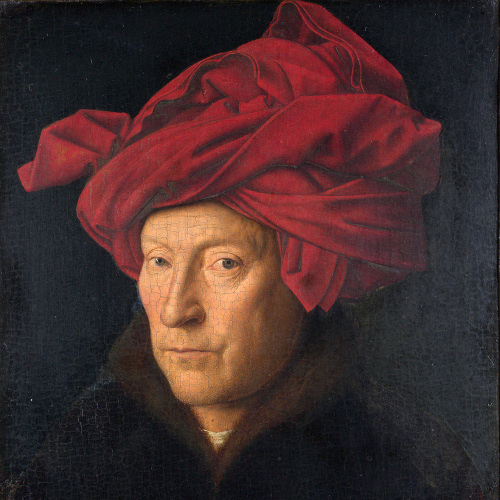Jan van Eyck
1390 (Maaseik, Belgique) / 1441 (Bruges, Belgique)
Tinged with mysticism, Van Eyck's polyphonic humanism succeeds in combining these two opposites, the real and the ideal. An art of the "immobilized gaze" (Pächt), the painting of the Fleming - and especially that of his ecstatic and precious Virgin and Child - seems to stop time in a "crystallization of light" (Panofsky). Difracting into an infinite number of rays - as the Arab astronomer Al-Haytham had discovered - on hundreds of gems, mirrors, armor and metal vessels, all of Van Eck's work is light. Sublimating action into "pure existence" (Panofsky), the artist extracts his meticulous reproduction of reality out of this very reality: Van Eyck realizes at the same time that he de-realizes. If he is not the inventor of the Flemish secret - the technique of oil painting has been used since the 12th century - he is nevertheless the one who perfects it to the highest degree, giving the impression that the light emanates from within the painting itself.
Jan van Eyck.
The Man with the Red Turban (Self-Portrait ?).
1436, oil on canvas, 25.5 × 19 cm
National Gallery, London.
Tinged with mysticism, Van Eyck's polyphonic humanism succeeds in combining these two opposites, the real and the ideal. An art of the "immobilized gaze" (Pächt), the painting of the Fleming - and especially that of his ecstatic and precious Virgin and Child - seems to stop time in a "crystallization of light" (Panofsky). Difracting into an infinite number of rays - as the Arab astronomer Al-Haytham had discovered - on hundreds of gems, mirrors, armor and metal vessels, all of Van Eck's work is light. Sublimating action into "pure existence" (Panofsky), the artist extracts his meticulous reproduction of reality out of this very reality: Van Eyck realizes at the same time that he de-realizes. If he is not the inventor of the Flemish secret - the technique of oil painting has been used since the 12th century - he is nevertheless the one who perfects it to the highest degree, giving the impression that the light emanates from within the painting itself.
Jan van Eyck.
The Man with the Red Turban (Self-Portrait ?).
1436, oil on canvas, 25.5 × 19 cm
National Gallery, London.
Artist's exhibitions
Van Eyck. Une révolution optique
01/02/2020 - 12/03/2020
(Gand) Musée des Beaux-Arts de Gand
01/02/2020 - 12/03/2020
(Gand) Musée des Beaux-Arts de Gand
